MRS/MRSI: Application
MRS/MRSI: Application
Oral
Oral
Spectroscopy & Non-Proton MR
Monday, 13 May 2019
| Room 513D-F | 13:45 - 15:45 | Moderators: Andrea Gropman, Martin Krssák |
13:45 |
0172. 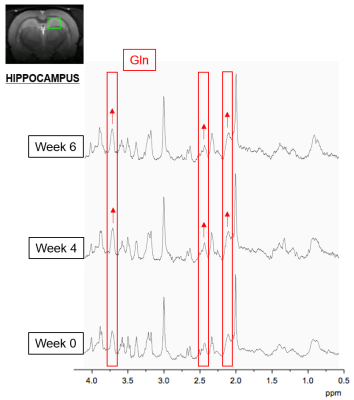 |
Antibiotic rifaximin for treatment of chronic liver disease-induced HE: a longitudinal in vivo 1H-MRS study of brain metabolism
Emmanuelle Flatt, Cristina Cudalbu, Olivier Braissant, Stefanita Mitrea, Dario Sessa, Valérie A. McLin, Rolf Grütter
Rifaximin is a commonly-used antibiotic to treat hepatic encephalopathy(HE), a complex neuropsychiatric syndrome caused by hepatic dysfunction. Rifaximin reduces the production of gut ammonia, the main toxin in HE pathogenesis. We hypothesized that the effect of rifaximin on neurometabolic profile is dose-related. Therefore, in this study, the effects of rifaximin administered at 6x human-dose were assessed, in vivo and longitudinally on brain metabolites in bile-duct ligated(BDL) rats using 1H-MRS at 9.4T, biochemical and behavioral tests. They were compared with non-treated and human-dose treated rats. We showed that higher-dose rifaximin treatment was associated with positive effects on brain Gln,Glu and osmoregulation.
|
13:57 |
0173.  |
The neurometabolic correlates of motor performance across the adult lifespan: a study on the effects of age
Akila Weerasekera, Oron Levin, Brad King, Kirstin Heise, Diana Sima, Sima Chalavi, Celine Maes, Lize Hermans, Ronald Peeters, Koen Cuypers, Sabine Van Huffel, Dante Mantini, Uwe Himmelreich, Stephan Swinnen
Aging is associated with alterations in neurochemistry of the brain, which can be assessed by MR spectroscopy. However, it’s unclear which metabolites are critical for function of the motor network. We explored whether changes in the neurometabolites of the aging brain account for motor-declines in bimanual coordination. We focused on neurochemistry of motor-occipital cortices as both regions are nodes of sensorimotor network underlying bimanual control. Myo-inositol was relevant for predicting Perdue test, which examine manual dexterity and general bimanual skills whereas N-acetylaspartate was associated with bimanual coordination task. Findings indicate NAA and mI could serve as biomarkers for integrity of motor network.
|
| 14:09 |
0174. 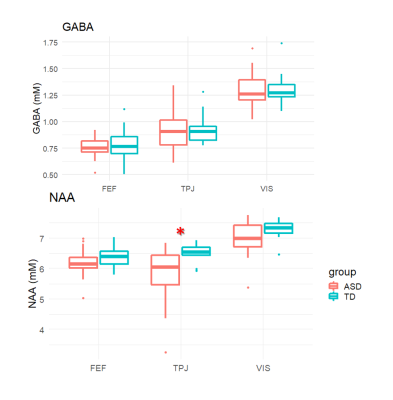 |
An MRS investigation of superior visual search abilities in children with autism spectrum disorder: Evidence for enhanced top-down attentional filtering
David Edmondson, Pingyu Xia, Brandon Keehn, Ulrike Dydak
Processing strengths or “islets of ability” associated with autism spectrum disorder (ASD), especially in visual search, have been of continued interest as they provide insight into how those with ASD perceive the world around them. In typically-developing (TD) individuals, region-specific concentrations of GABA are associated with differences in attention and perception. ASD may be associated with an excitatory-inhibitory imbalance, however, it remains unclear how this may contribute to superior search abilities. To test this, 37 ASD and TD children participated in a magnetic resonance spectroscopy study using MEGA-semi-LASER to detect GABA concentrations in cortical regions associated with attention and perception.
|
14:21 |
0175. 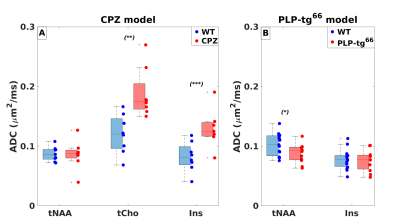 |
Glial and axonal changes in mouse models of disease investigated with diffusion-weighted magnetic resonance spectroscopy at 11.7 T
Guglielmo Genovese, Mathieu Santin, Marco Palombo, Julien Valette, Clemence Ligneul, Marie-Stéphane Aigrot, Mehdi Felfli, Nasteho Abdoulkader, Dominique Langui, Aymeric Millecamps, Anne Baron-Van Evercooren, Bruno Stankoff, Stéphane Lehericy, Alexandra Petiet, Francesca Branzoli
The goal of this study was to evaluate the alterations of white matter microstructure in two different mouse models of white matter disease: the cuprizone (CPZ) model of multiple sclerosis and the Plp1 overexpressing (PLP-tg66) model of Pelizeaus-Merzbacher disease. To this end, we employed diffusion-weighted MR spectroscopy (DW-MRS) to measure concentrations and apparent diffusion coefficients of several metabolites in the corpus callosum of wild-type, CPZ and PLP-tg66 mice at 11.7 T. DW-MRS markers of axonal and glial degeneration were compared with histological measures.
|
| 14:33 |
0176.  |
Elevated brain glutamate levels in type 1 diabetes
Evita Wiegers, Hanne Rooijackers, Jack van Asten, Cees Tack, Arend Heerschap, Bastiaan de Galan, Marinette van der Graaf
Type 1 diabetes affects the structure and functioning of the brain, but the neurochemical mediators that may accompany these negative effects are largely unknown. We investigated brain metabolite levels with 1H MRS in patients with type 1 diabetes and normal awareness of hypoglycemia, patients with impaired awareness of hypoglycemia (IAH) and non-diabetic controls. Brain glutamate levels were elevated in type 1 diabetes and correlated with glycemic control and age of disease onset, but not with burden of hypoglycemia as reflected by IAH. This suggests a potential role for glutamate as early marker of hyperglycemia-induced cerebral decline in type 1 diabetes.
|
| 14:45 |
0177.  |
Remote metabolic profile changes in subacute spinal cord injury
Patrik Wyss, Markus Berger, Anke Henning
Not a single MR marker has been identified to predict patient outcome in spinal cord injury (SCI) rehabilitation. Therefore, we applied magnetic resonance spectroscopy (MRS) to examine metabolite concentration in the pons around 10 weeks after injury and identify group differences in complete and incomplete SCI at the time of the MRS acquisition.
|
| 14:57 |
0178. 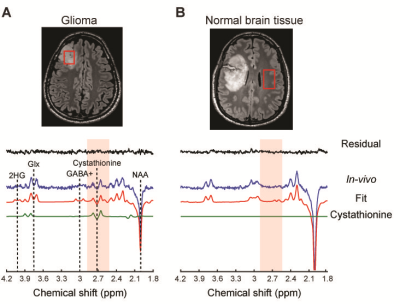 |
In vivo cystathionine detection in gliomas by edited 1H magnetic resonance spectroscopy
Francesca Branzoli, Dinesh Deelchand, Anna Luisa Di Stefano, Marc Sanson, Stéphane Lehéricy, Malgorzata Marjanska
This study reports the first measurement of cystathionine in vivo. Cystathionine was measured using the edited magnetic resonance spectroscopy (MRS). The identification of cystathionine was confirmed by comparing in vivo spectra acquired in gliomas with the cystathionine spectrum measured in a phantom at physiological pH and temperature and with a simulated spectrum generated using accurate chemical shifts and J-coupling constants. The noninvasive detection of cystathionine by MRS may represent a new in vivo marker of glioma subtypes which will benefit diagnosis and treatment of patients with gliomas.
|
| 15:09 |
0179. 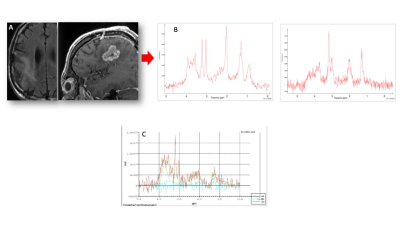 |
Importance of early spectral variations during 48 months of longitudinal follow-up MRI and MRS in 100 patients treated glioblastoma
Jean-Marc CONSTANS, A. Heintz, J.P. Chombar, F. Dallery, S. Metambou, O. Seloi , N. Deleval , D. Michel, S. Boussida, R. Hanafi, C. Corcy, W. Dou , S. Ruan, D. Le Gars , H. Deramond, A. Houessinon, A. Fichten , M. Lefranc, A. Coutte, P. Toussaint , C. Desenclos , B. Chauffert , M. Boone
MRS with Cho/Cr, Lac/Cr, CH2/Cr and NAA/Cr ratios, could be more sensitive than MRI and could, in some cases, be predictive of worsening in glioblastomas follow-up. These spectroscopic changes occurred well before clinical deterioration. There is a large variability, but repetition and modelisation of spectroscopic measurements during longitudinal follow-up could allow us to diminish it and to improve glioblastomas prognostic evaluation especially at and after relapses. Studying the relationship between MRS measures, segmentation and perfusion parameters could lead to better understanding of therapeutic response and patients selection, especially with regard to chemotherapy and antiangiogenic molecules and in future stress modulators.
|
| 15:21 |
0180. 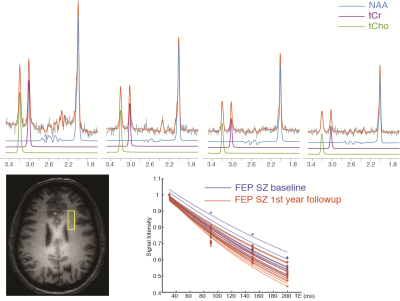 |
Metabolite relaxation and diffusion abnormalities in the white matter of first-episode schizophrenia: a longitudinal study
Xi Chen, Xiaoying Fan, Talia Cohen, Margaret Gardner, Fei Du, Dost Ongur
Microstructural abnormalities in the white matter are important in the pathophysiology of schizophrenia. Unlike to unspecific nature of water, MRS can probe the brain's intracellular microenvironment through the measurement of transverse relaxation and diffusion of neurometabolites and even providecell-specific information. In this study, we worked with first episode schizophreniapatients so as to obviate the effects of medications and toxic effects of chronic psychosis. A combination of the T2-MRS and DTS techniques were applied in a longitudinal study. NAA T2 and ADC showed more sensitive changes compared to water at the early stage of disease.
|
15:33 |
0181. 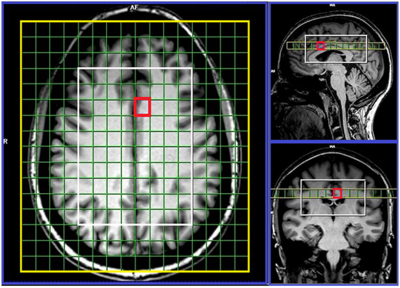 |
Spiral-MRSI and tissue segmentation of normal-appearing white matter and white matter lesion load in relapsing remitting Multiple Sclerosis.
Oun Al-iedani, Karen Ribbons , Jeannette Lechner-Scott, Scott Quadrelli, Rodney Lea, Ovidiu Andronesi, Saadallah Ramadan
The study evaluated a novel Fast-MRSI technique with tissue segmentation in determining metabolic alterations in NAWM and WM-lesions in MS compared to healthy controls. 3D-MPRAGE and 3D-Spiral-MRSI covering 70% of total brain on 16 RRMS and 9 HCs (aged 22-55yrs) were used. MRSI was processed using MATLAB and LCModel. Findings revealed that (NAA/tCr) in WM-lesions was significantly lower than NAWM-MS and HCs. Volumetric segmentation using SIENAX, revealed a significant WBV reduction and CSF increase in RRMS compared to HCs. Fast-MRSI may enhance diagnosis and clinical monitoring of MS patients, and is sensitive in diagnosing MS even in NAWM.
|
 Back to Program-at-a-Glance |
Back to Program-at-a-Glance |  Back to Top
Back to Top